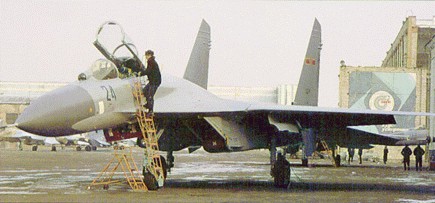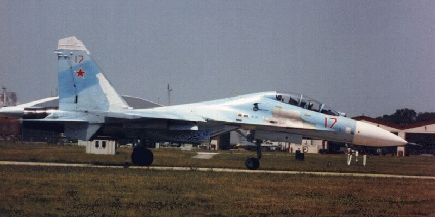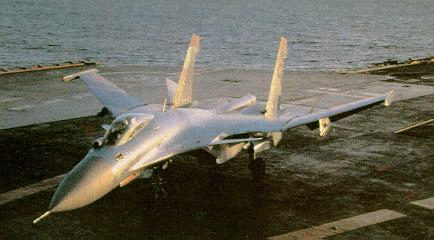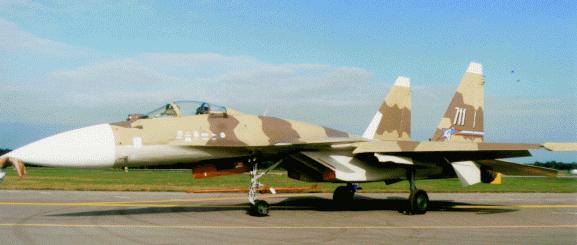































 That could be dangerous if the computer systems fail. The Phazatron N001 Zhuk (beetle), track-while-scan coherent pulse Doppler radar has a range of 103km, the laser range finder can be slaved to the pilots helmet mounted sight and be displayed on the wide angle HUD. The electro-optical search and track sensor allow the Flanker to search and track and enemy aircraft without radar emissions giving away their position. Both of the engines are linked to the flight control system to ensure optimum performance. This allows the Flanker to perform impressive maneuvers such as 'Pougachev's Cobra' which no other aircraft previously has been able to perform.
That could be dangerous if the computer systems fail. The Phazatron N001 Zhuk (beetle), track-while-scan coherent pulse Doppler radar has a range of 103km, the laser range finder can be slaved to the pilots helmet mounted sight and be displayed on the wide angle HUD. The electro-optical search and track sensor allow the Flanker to search and track and enemy aircraft without radar emissions giving away their position. Both of the engines are linked to the flight control system to ensure optimum performance. This allows the Flanker to perform impressive maneuvers such as 'Pougachev's Cobra' which no other aircraft previously has been able to perform.
 The Su-30 is a long range air-superiority fighter. Due to the in-flight-refueling capability it can either remain on station for long periods or cover a large area on patrol. It incorporates a new navigation and fire and control system allowing to operate in the command role for a tactical formation. Similarly like the Mig31 it can operate in a formation where only the command aircraft needs to illuminate through the use of radar while the data is share with the other aircraft trough a secure datalink. The Su-30 MK is another development which has improved air to ground capability. It is a truly multirole aircraft with either a very quick turn around time or is able to complete both air to air and air to ground missions in the one flight. Two additional under wing storage points were added to allow up to 12 stores to be carried. In the Su30MK the second seat takes the more traditional role of the weapons system operator while in the Su-27UB and Su-30 they are really a copilot. A modified prototype of the Su30 was the first aircraft in the world to accelerate through the speed of sound vertically (up not down!). While other aircraft have been able to travel supersonic vertically none had previously been able to accelerate to that extent (at least not reportedly). The Su 30 was able to do this thanks to an increased amount of composites used in the airframe to save weight. These differ from the Su 27 by the capacity of 2 extra tech points, and being themselves two-seater aircraft.
The Su-30 is a long range air-superiority fighter. Due to the in-flight-refueling capability it can either remain on station for long periods or cover a large area on patrol. It incorporates a new navigation and fire and control system allowing to operate in the command role for a tactical formation. Similarly like the Mig31 it can operate in a formation where only the command aircraft needs to illuminate through the use of radar while the data is share with the other aircraft trough a secure datalink. The Su-30 MK is another development which has improved air to ground capability. It is a truly multirole aircraft with either a very quick turn around time or is able to complete both air to air and air to ground missions in the one flight. Two additional under wing storage points were added to allow up to 12 stores to be carried. In the Su30MK the second seat takes the more traditional role of the weapons system operator while in the Su-27UB and Su-30 they are really a copilot. A modified prototype of the Su30 was the first aircraft in the world to accelerate through the speed of sound vertically (up not down!). While other aircraft have been able to travel supersonic vertically none had previously been able to accelerate to that extent (at least not reportedly). The Su 30 was able to do this thanks to an increased amount of composites used in the airframe to save weight. These differ from the Su 27 by the capacity of 2 extra tech points, and being themselves two-seater aircraft.
 While it is not assisted by a catapult the Su33 has a higher thrust to weight ratio and also, due to better aerodynamics, generates more lift. Flaperons were replaced with slotted high lift flaps to increase lift and control at low speeds. Comment from US Naval aviators who visited the Kuznetsov about the Su-33 consistently praised their ability to climb immediately after launch instead of 'hanging' in the air like their catapult launched aircraft. Su-33 Naval Flanker By 1990 20 had been producedand they were deployed on the aircraft carrier Kuznetsov in late 1995. The longitudinal triplane layout of the Su-33 gives it exceptional maneuverability, even with heavy loads. The Su-33 is intended for fleet air defense (like the F-14 is) but is also to have a secondry anti-ship capability.The other attack aircraft to compliment the Su-33 on the carrier is a navalised Su-25. 10 Tech Points, and folding wings,
While it is not assisted by a catapult the Su33 has a higher thrust to weight ratio and also, due to better aerodynamics, generates more lift. Flaperons were replaced with slotted high lift flaps to increase lift and control at low speeds. Comment from US Naval aviators who visited the Kuznetsov about the Su-33 consistently praised their ability to climb immediately after launch instead of 'hanging' in the air like their catapult launched aircraft. Su-33 Naval Flanker By 1990 20 had been producedand they were deployed on the aircraft carrier Kuznetsov in late 1995. The longitudinal triplane layout of the Su-33 gives it exceptional maneuverability, even with heavy loads. The Su-33 is intended for fleet air defense (like the F-14 is) but is also to have a secondry anti-ship capability.The other attack aircraft to compliment the Su-33 on the carrier is a navalised Su-25. 10 Tech Points, and folding wings,
 And it is a challenge which has not been taken up. The Su-37 Super Flanker is yet another development of the Su-27 (which now seems basic in comparison!). The main improvement/addition in this development is the addition of the AL-37FU thrust vectoring engines. When the Su-37 was displayed at Farnbrough in 1996 it stole the show. Under the control of Sukhoi's Chief Test Pilot, Eugeny Frolov, the Su-37 performed some astounding maneuvers. These inclded the "Super Cobra", demonstrated for the first time. In this move the aircraft enters with a speed of 400kmh and is pulled through to an alpha of 135 deg, then recovered to the vertical using TV and held in place for 4-6 seconds. After hanging in the air the nose is allowed to fall to the horizontal position and emerging at 150 km/h and no loss of height! Another was basically using the TV to flip the Su-37 onto it's back and then to rotate it upright and continue on level in the direct opposite direction to which it had come. All in not much more than the length of the whole aircraft! The most impressive maneuver though, was the kulbit (somersault). With an entry speed of 350 km/h the aircraft is flipped onto it's back (a full 180 deg) facing the opposite direction, inverted and practically stationary. Then after 'pausing' there TV is used to complete the kulbit (360 deg somersault) with a nose down angle of 30 deg and an exit speed of 60 km/h! While this is impressive to read it has to be seem to be be ieved. On the Janes WWW site there are a number of .mov films which show these amazing maneuvers.
And it is a challenge which has not been taken up. The Su-37 Super Flanker is yet another development of the Su-27 (which now seems basic in comparison!). The main improvement/addition in this development is the addition of the AL-37FU thrust vectoring engines. When the Su-37 was displayed at Farnbrough in 1996 it stole the show. Under the control of Sukhoi's Chief Test Pilot, Eugeny Frolov, the Su-37 performed some astounding maneuvers. These inclded the "Super Cobra", demonstrated for the first time. In this move the aircraft enters with a speed of 400kmh and is pulled through to an alpha of 135 deg, then recovered to the vertical using TV and held in place for 4-6 seconds. After hanging in the air the nose is allowed to fall to the horizontal position and emerging at 150 km/h and no loss of height! Another was basically using the TV to flip the Su-37 onto it's back and then to rotate it upright and continue on level in the direct opposite direction to which it had come. All in not much more than the length of the whole aircraft! The most impressive maneuver though, was the kulbit (somersault). With an entry speed of 350 km/h the aircraft is flipped onto it's back (a full 180 deg) facing the opposite direction, inverted and practically stationary. Then after 'pausing' there TV is used to complete the kulbit (360 deg somersault) with a nose down angle of 30 deg and an exit speed of 60 km/h! While this is impressive to read it has to be seem to be be ieved. On the Janes WWW site there are a number of .mov films which show these amazing maneuvers.
| ||||||||||||||||||||||||||||||||||||||||||||||||||
| ||||||||||||||||||||||||||||||||||||||||||||||||||
| ||||||||||||||||||||||||||||||||||||||||||||||||||
| |||||||||||||||||||||||||||||
| |||||||||||||||||||||||||||||
|